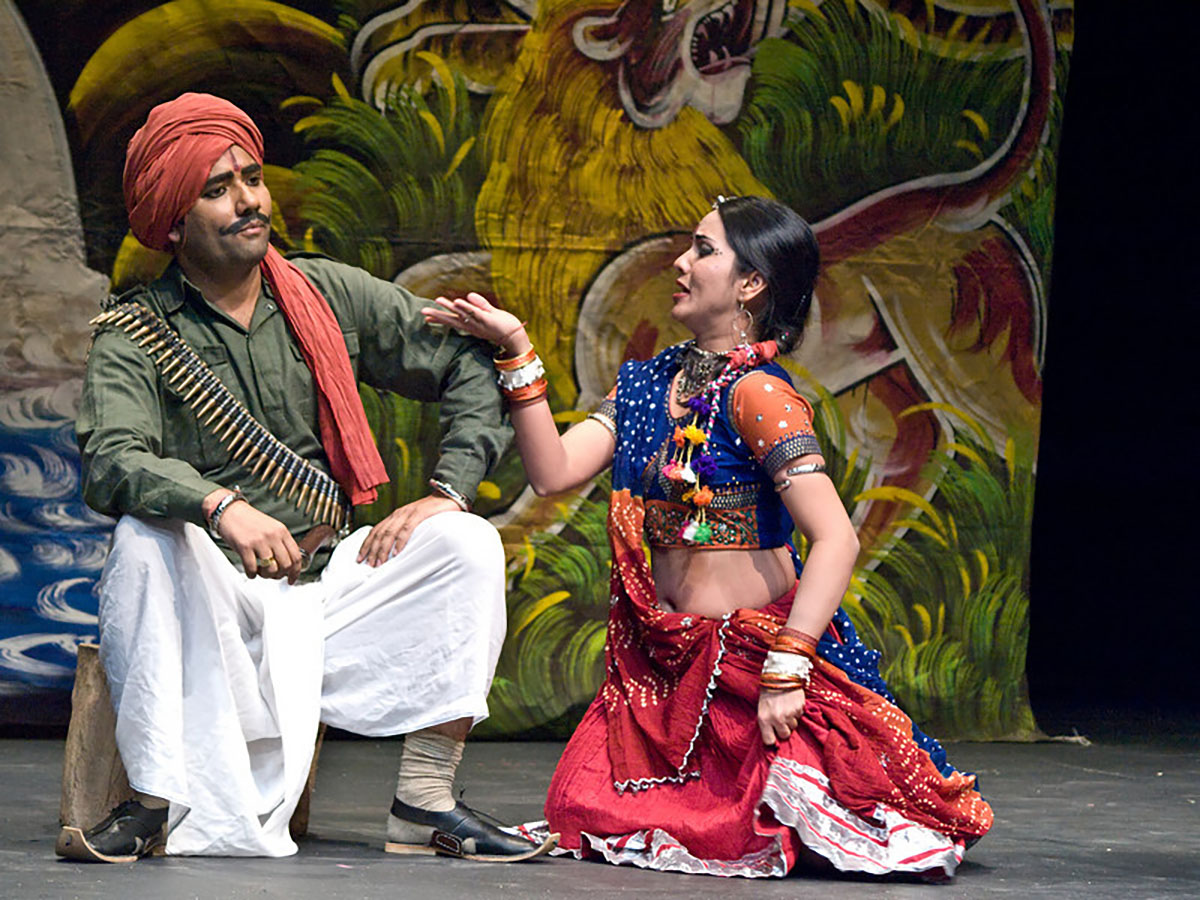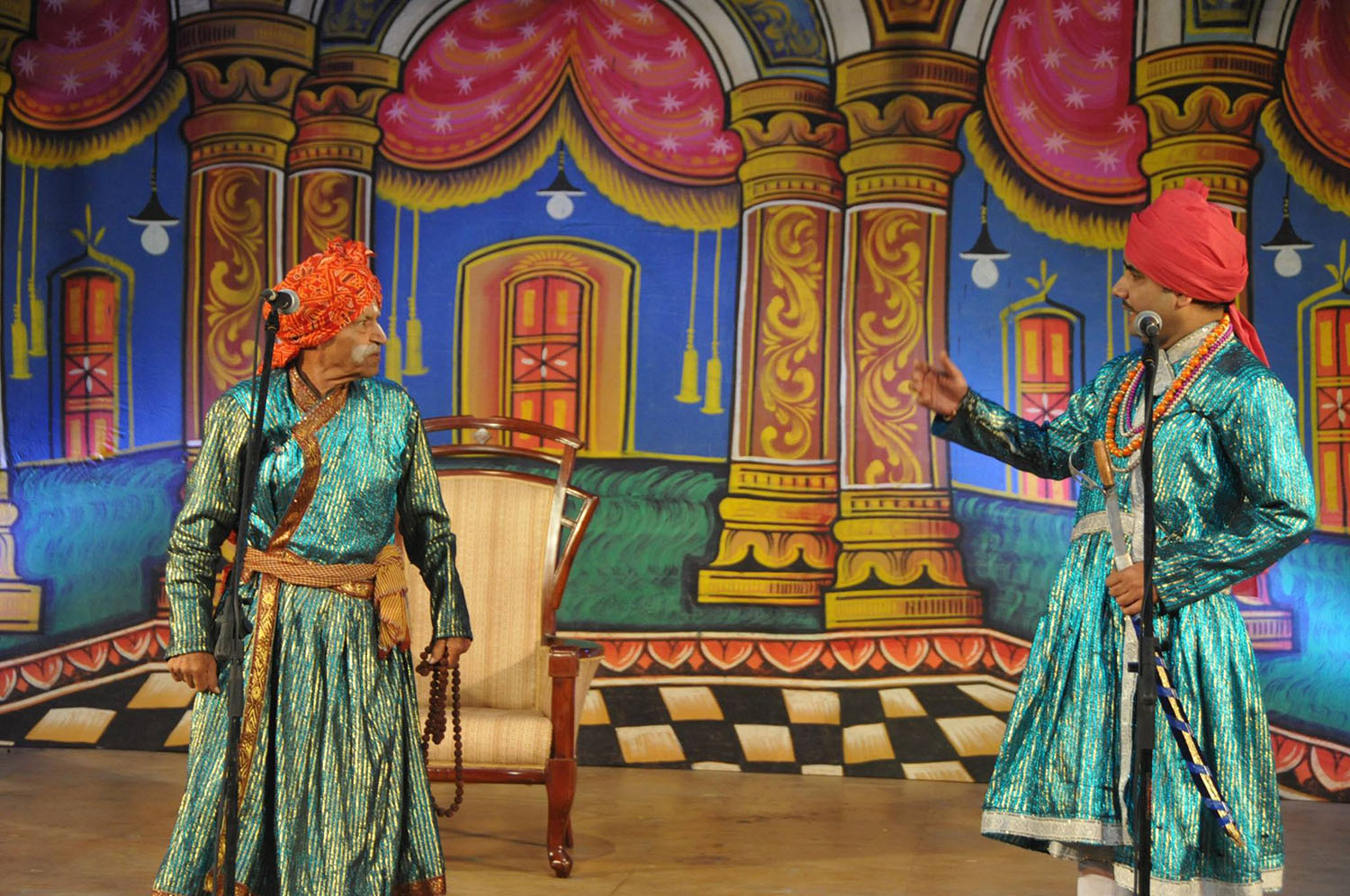ARTICLE
Nautanki
A popular folk theatre form that combines music, dance, dialogue and narrative, nautanki originated and grew into popularity in Uttar Pradesh in the nineteenth century. Nautanki may have originated from bhagat, a dramatised religious singing form. It also shares similarities with naqal from Punjab, tamasha from Maharashtra, khyal from Marwar, maach from Madhya Pradesh and jatra from Bengal.
The etymology of the term is debated; while some scholars suggest that the term derived from the Sanskrit nataka, meaning “drama,” others suggest that it originated from folklore about Princess Nautanki of Multan, which formed the basis of some of the earlier poems and plays written for this theatre form. Before the popularity of the Princess Nautanki story lent its name to the form around the 1920s, it was largely referred to as svang (farce) and continues to be known by this name in the Hathras and Braj regions of Uttar Pradesh.
Nautanki is primarily a form of entertainment, with stories and themes derived largely from secular sources, including popular legends and tales from North India; Arabic and Persian romances; folk epics from Rajasthan, Punjab and Uttar Pradesh; stories of saints, kings, heroes and contemporary incidents; and themes of social inequality and gender violence.
Hathras and Kanpur emerged as the two major centres for nautanki in the late nineteenth century. The Hathras school emerged from a series of svangs produced within an akhara (a predominantly male space for practising music, poetry, drama and wrestling) established by the poet Indarman in the 1890s. This style emphasised music, beginning with a dhrupad and incorporating classical Hindustani compositions and songs. During the 1910s, Kanpur emerged as an important nautanki centre, developing a style distinctive from Hathras and influenced by the growing popularity of Parsi theatre, with the inclusion of a proscenium stage and curtains to the performances as well as a focus on dialogue, expression, acting and stage design.
Nautanki performances frequently attracted royal patronage, notably from Wajid Ali Shah, the last Nawab of Lucknow (r. 1847–56). His reign saw an increase in the use of Islamicate themes in the plot, costume, speech, musical composition and stage designs in local theatre: this is generally attributed to the popularity of the play Indarsabha, written by Agha Hasan Amanat. Urdu terms also began to appear more frequently, and stories such as Syahposh, Benazir Badremunir and Laila Majnun began to be adapted into plays. In Kanpur, the akharas of Lalman Numberdar and Shri Krishan Pahlwan emerged as important centres. Following the social turbulence brought on by the Indian Revolt of 1857, royal patronage from the Nawab came to an end, and nautanki began developing through the efforts of individuals and troupes.
Nautanki went on to become a commercially viable form from the 1930s onwards, emerging as an important medium for anti-colonial assertion through plays such as Rashtriya Saangit Julmi Dayar (1922) by Manoharlal Shukla, which depicted the Jallianwala Bagh massacre; Gandhi Harass (1932) by Lal Babu, which supported civil disobedience; and Balia Balidan by Munindra Nath Goswami, which promoted unity between Hindus and Muslims. Another play that emerged during the Quit India Movement was Aurat ka Pyaar (1942), which was performed by Tirmohan Lal’s company at Phool Bagh, Kanpur. The play included a scene that depicted a woman slapping a British police officer, which was applauded by the audience and led to anti-British slogans being raised when it was first performed in 1942.
The script of a svang or nautanki performance is known as sangit, meaning “music” or “musical drama.” Nautanki employs Hindi poetic conventions such as the doha and chaubola and the Urdu prose types of sher, qawwali and ghazal, combined with regional genres such as dadra, thumri, savan, mand and lavani, among others. The music follows a rudimentary raga structure through metred cycles and rhythmic inflections in repetitions of three known as tihai. A typical nautanki performance alternates between sung verses and instrumental segments that employ the nagara (kettledrum), shahnai (clarinet) and harmonium. The performance begins with a prayer, followed by an introduction of the theme by a sutradhar, who would repeat his lines on all the corners of the open stage for the audience. The drama would be interspersed with comedic breaks by a “joker” (a term borrowed from the circus).
Nautanki troupes consisted of performers from diverse backgrounds, across castes and religions. Whereas initially, only men were allowed to join nautanki troupes, in the 1920s, women began entering the stage. These actors typically belonged to courtesan families or communities such as the Kalbeliyas, Bedias and Nats. Women nautanki actors rose to popularity in the 1950s and 1960s, with some setting up their own companies. Gulab Bai, a well-known nautanki actor, set up the Great Gulab Theatre Company; another actor, Krishna Bai, set up the Krishna Nautanki Company.
The advent of cinema drastically impacted nautanki, resulting in waning audience interest in the form. Today, it persists in the rural areas of Hathras, Mathura, Unnao and Beeghapur in Uttar Pradesh. Interest in nautanki is also gradually increasing in metropolitan cities in India and among the Indian diaspora, with mainstream theatre also adapting the genre. Nautanki has also had a significant impact on popular music, with labels such as His Master’s Voice (HMV) releasing records of nautanki music sung by Gulab Jan in 1969. Songs composed for nautanki plays have also been used in famous Hindi cinema songs. The form was also featured in theatre festivals organised by the Andhra Pradesh Sangeet Natak Akademi in 2001 and the Delhi Hindi Akademi Nautanki fest in 2004, where Krishna Kumari Mathur and Company performed Amar Singh Rathore. The Great Gulab Theatre Company also occasionally performs plays on request, such as their performance of Sultana Daaku at the India Habitat Centre, New Delhi in 2010.
Practitioners such as Pandit Ram Dayal Sharma and Devendra Sharma and directors such as Habib Tanvir, Sarvesh Dayal Saxena, Atul Yaduvanshi and Urmil Kumar Thapliyal have utilised nautanki techniques in their work. Nautanki performers Shrikrishna Pehelwan and Gulab Bai received the *Sangeet Natak Akademi* awards in 1968 and 1990, respectively. Today, nautanki is used as a popular form to spread social awareness by governmental and non-governmental agencies. Nautanki performances take place in cultural festivals, tourist venues such as the annual Surajkund International Crafts Fair, held in Faridabad, Haryana, and are incorporated in collegiate theatre productions.
Bibliography
Our website is currently undergoing maintenance and re-design, due to which we have had to take down some of our bibliographies. While these will be re-published shortly, you can request references for specific articles by writing to hellomapacademy@map-india.org.








